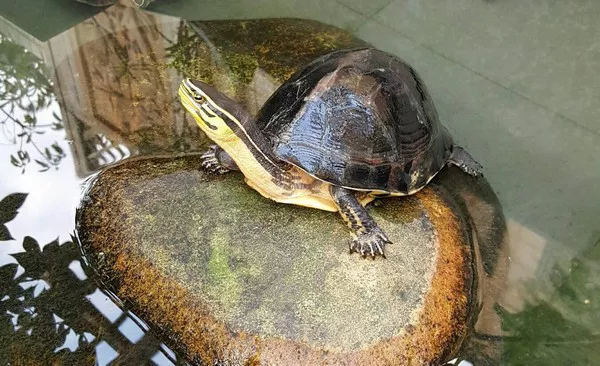In the vast expanses of the world’s oceans, an intriguing phenomenon captures the attention of marine biologists and enthusiasts alike – the ability of turtles to consume jellyfish. While jellyfish are often deemed hazardous due to their stinging tentacles, turtles have evolved mechanisms that allow them to not only navigate this perilous encounter but also to incorporate jellyfish into their diet. This article delves into the fascinating world of turtle physiology, behavior, and adaptations, unveiling the intricate ways in which these marine reptiles can devour jellyfish without succumbing to their venomous defenses.
The Culinary Predilection of Turtles
Turtles, belonging to the order Testudines, exhibit a diverse array of dietary preferences. While some species are herbivores, others are omnivores, and some are even predominantly carnivorous. The predilection for jellyfish as a food source is particularly notable in certain sea turtle species, such as the leatherback turtle (Dermochelys coriacea) and the loggerhead turtle (Caretta caretta). The question that naturally arises is: How do these turtles manage to consume a prey item armed with venomous cells capable of incapacitating other marine creatures?
Venomous Challenge: Tackling the Sting
The tentacles of jellyfish are equipped with specialized cells called cnidocytes, which house stinging structures known as nematocysts. These nematocysts contain toxins that are potent enough to deter most predators. However, turtles have evolved remarkable strategies to overcome this venomous challenge.
One key adaptation is the structure of the turtle’s throat. Unlike many other animals, the throat of a turtle is not lined with sensitive tissues that would be vulnerable to the stinging cells of jellyfish. Instead, the throat is lined with tough, keratinized spines that provide a protective barrier against the venom. This adaptation allows turtles to ingest jellyfish without suffering the consequences of their stinging tentacles.
Furthermore, studies have revealed that some turtle species, particularly the leatherback turtle, possess a high tolerance for certain types of toxins found in jellyfish venom. The leatherback turtle’s esophagus contains enzymes capable of breaking down and neutralizing the toxins, allowing the turtle to safely consume jellyfish without adverse effects.
The Art of Consumption: Techniques Employed by Turtles
Turtles employ various techniques to consume jellyfish efficiently. One such technique involves the use of their beaks, which are adapted to tear and manipulate jellyfish tentacles. The beaks of sea turtles are serrated and well-suited for grasping slippery and gelatinous prey. Observations of feeding behaviors have shown that turtles use their powerful jaws and beaks to tear apart the jellyfish, avoiding the tentacles with their stinging nematocysts.
Additionally, turtles often employ a suction-feeding mechanism. By creating a vacuum in their mouths, they can draw in water along with the jellyfish, minimizing the risk of contact with the venomous tentacles. This suction-feeding strategy is not only efficient but also aids in preventing potential harm from the jellyfish’s defenses.
Navigating the Gelatinous Realm: Specialized Adaptations
Jellyfish are soft-bodied and gelatinous, making them a challenging prey item for many predators. However, turtles have evolved specialized adaptations that allow them to navigate and thrive in the gelatinous realm.
The flippers of sea turtles, for instance, are adapted for both locomotion and manipulation of prey. These flippers, equipped with powerful muscles, provide turtles with the agility and dexterity needed to navigate through water and capture elusive jellyfish. The streamlined body shape of sea turtles further enhances their ability to move swiftly through the water, allowing them to pursue and capture jellyfish effectively.
Moreover, the sensory organs of turtles play a crucial role in detecting and locating jellyfish. Sea turtles possess highly developed eyesight, allowing them to spot prey from a distance. In addition, their keen sense of smell helps them detect the chemical cues released by jellyfish, enabling them to locate their prey in vast ocean expanses.
Ecological Significance: Turtles as Jellyfish Regulators
Understanding the dynamics of the relationship between turtles and jellyfish goes beyond the realm of fascinating biology; it has broader implications for marine ecosystems. Sea turtles, through their consumption of jellyfish, play a crucial role in regulating jellyfish populations.
Jellyfish blooms, characterized by an exponential increase in jellyfish numbers, can have detrimental effects on marine ecosystems. They can outcompete other marine organisms for food and space, leading to disruptions in the balance of the ecosystem. By preying on jellyfish, turtles act as natural regulators, helping to control jellyfish populations and maintain the ecological equilibrium of their habitats.
However, the intricate interplay between turtles and jellyfish also raises concerns about the potential impact of environmental changes on this delicate balance. Climate change, pollution, and habitat destruction can all influence the distribution and abundance of jellyfish and, consequently, impact the foraging behavior of turtles. Understanding these complex interactions is crucial for implementing effective conservation strategies.
Conservation Challenges: Threats to Turtles and Jellyfish
While turtles have evolved remarkable adaptations to consume jellyfish, they face numerous threats in today’s rapidly changing environment. Human activities, such as habitat destruction, pollution, and climate change, pose significant challenges to the conservation of sea turtles and their interactions with jellyfish.
Plastic pollution, in particular, is a growing concern for marine life. Turtles, often mistaking plastic bags for jellyfish, can ingest these harmful materials. The ingestion of plastics not only poses a direct threat to the health of turtles but also disrupts their feeding behavior. Plastic debris in the ocean can alter the scent and visual cues used by turtles to locate jellyfish, leading to potential declines in their foraging success.
Climate change is another major threat affecting both turtles and jellyfish. Changes in sea temperature and ocean currents can influence the distribution and abundance of jellyfish, impacting the availability of this crucial food source for turtles. Additionally, rising temperatures can skew the sex ratios of turtle hatchlings, potentially leading to imbalances in future populations.
See Also:What Do You Need to Have a Pet Turtle?
Conservation Strategies: Mitigating Threats and Preserving Interactions
Addressing the conservation challenges faced by turtles and jellyfish requires a multifaceted approach that encompasses habitat protection, pollution reduction, and climate change mitigation.
Habitat Protection: Establishing and enforcing protected areas for nesting and feeding habitats is essential for the conservation of sea turtles. Preserving these areas ensures that turtles have access to suitable environments for nesting and foraging, contributing to the sustainability of their populations.
Pollution Reduction: Mitigating the impact of plastic pollution involves both individual and collective efforts. Public awareness campaigns, waste reduction initiatives, and the development of sustainable alternatives can contribute to reducing the influx of plastics into marine environments.
Climate Change Mitigation: Addressing the root causes of climate change is critical for the long-term survival of marine ecosystems. International cooperation to reduce greenhouse gas emissions, promote sustainable practices, and implement climate-resilient strategies can help mitigate the impacts of climate change on turtles and jellyfish.
Research and Monitoring: Continued research on the biology, behavior, and interactions between turtles and jellyfish is essential for informed conservation strategies. Monitoring changes in jellyfish populations, understanding the effects of environmental variables, and assessing the health of turtle populations contribute to a comprehensive conservation approach.
Conclusion
The enigma of how turtles consume jellyfish unveils a captivating narrative of adaptation, survival, and ecological interconnectedness. As these marine reptiles navigate the challenges posed by venomous tentacles, gelatinous bodies, and changing environmental conditions, their ability to regulate jellyfish populations underscores their significance in maintaining the balance of marine ecosystems.
Preserving the delicate dance between turtles and jellyfish requires concerted efforts on a global scale. By addressing the threats posed by habitat degradation, pollution, and climate change, we can ensure the continued existence of these remarkable creatures and the intricate relationships that define our oceans. In doing so, we not only safeguard the future of turtles and jellyfish but also contribute to the overall health and resilience of marine ecosystems.
Related Topics:
How Long Do Box Turtles Live in Captivity?
What fruits do box turtles eat?
What Do Box Turtles Eat and How Often: A Guide


























